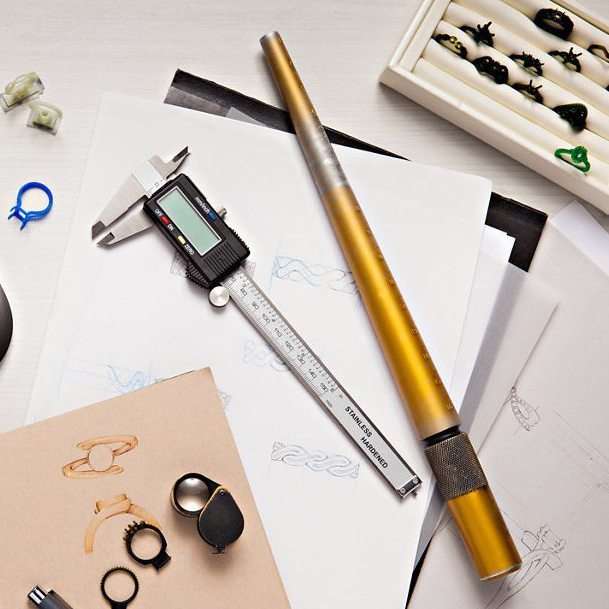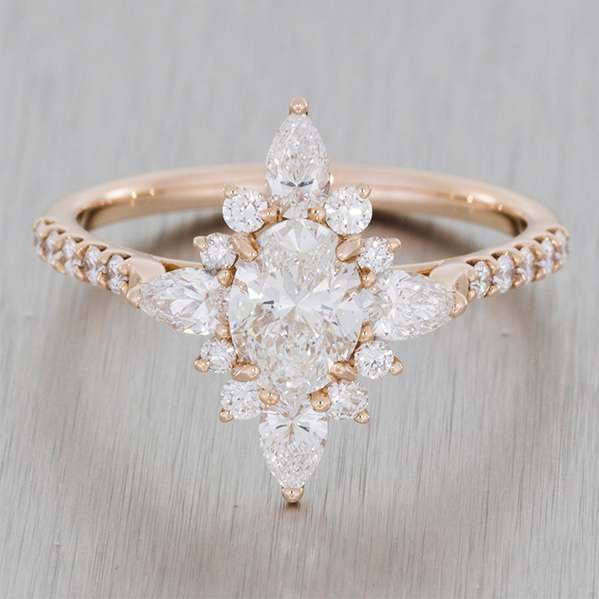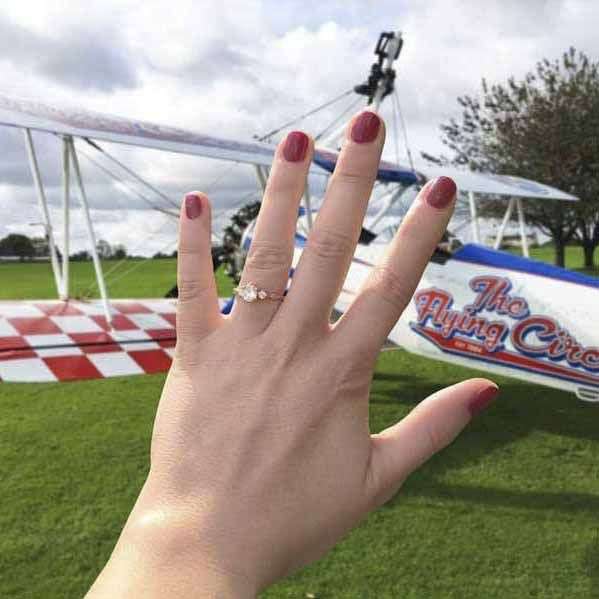Diamonds have historically and traditionally been cut into round shapes as it is thought that this shape produces the most dazzling light performance, thus creating the distinctive diamond ‘sparkle’. Diamonds are also available in other shapes and there is an increasing popularity for a non-traditional cut diamond.
Round Brilliant Cuts
Engineered and developed over centuries of diamond cutting- the Round Brilliant Cut is the most popular and the most abundant cut, representing approximately 75% of all diamonds sold. It has 57/58 facets depending on if the culet has been cut and displays the best brilliance and light performance. We would always recommend going for a diamond with an ‘Ideal’ or ‘Excellent’ cut grade; any lower than that and the diamond will leak light and have a dimmer ‘sparkle’.

Princess Cut
Perhaps the second most popular stone cut in the market, the Princess Cut displays incredible fire and brilliance. Considering its birth in the 1980’s, the Princess Cut can be seen as a contemporary favourite. Due to its facets, it provides jewellery with a geometric and angular aesthetic. When choosing a Princess Cut stone, make sure to look at the proportions so it is a true square rather than being slightly elongated. The Princess Cut is the most economical in terms of using the most of the rough stones. From a standard octahedron you can usually cut two Princess Cuts with minimal wastage occuring the cutting and polishing of the stones.

Oval Diamonds
Oval diamonds are a modified Brilliant Cut, meaning that the Brilliant facets on the Round Brilliant are modified for an Oval shape to bring the best light performance and sparkle. The elongated effect can have a very flattering look to the wearer making the finger look longer and slimmer. Oval diamonds can vary a lot in the look from being longer and thinner or shorter and wider. Everyone has the preference of this look, the most popular ratio is usually 1.35-1.5 to make the most appealing shape. The shape and cut can also create what is called a ‘bow-tie’ on the diamond. This is where the light is not reflected back properly so it creates a dark shadow in the centre of the stone that can resemble a bow tie. When we source oval cuts we always try to make sure the stone has little to no bow-tie.

Marquise Diamonds
The elongated marquise cut is another modified brilliant cut, it is very flattering for the wearer giving a longer and slimmer look. Marquise stones can also show bow-ties depending on the cut and proportions on the stone. And like oval cuts we always inspect them to make sure the bow tie is invisible. Symmetry is really important for marquise cut diamonds as any misalignment of the points and then the two sides can look quite drastic when set in jewellery. The most important thing is to be happy with the proportions and then to make sure that the stone is symmetrical.

Pear Cut Diamonds
In the same family of elongated modified brilliant cut, the beautiful pear cut is a great combination of round and marquise with the point at one end. Like marquise and oval, the pear cut can be elongated or shorter and rounder, in any case, it will always be flattering and make the finger look longer and slimmer. Symmetry is also hugely important for pear cuts and having a good cut can also reduce the bow-tie. Personal preference will always dictate the choice of these cuts, however, the most ideal ratio is 1.4-1.7.

Cushion Cut Diamond
Cushion cuts are the modern version of the antique old mine cuts, until the 20th century, this was the most popular cut (see antique diamond cut page). The cushion cut, similar to the princess cut is a great shape for saving weight of the rough crystal and can give a real soft yet unique look. Cushion cut diamonds are classically cut to very square proportions, however, they can often be found elongated as well and have a more rectangular look to them this ratio would generally be 1.1-1.2.

Emerald Cut Diamonds
The most popular step cut diamond, heavily used in art deco and geometric style jewellery. The step cut creates the opposite effect to the brilliant cut, where it has long linear facets that emphasize a ‘hall-of-mirrors’ look. Giving flashes of light and dark rather than the fire you get with brilliant cuts. The classic emerald cut usually has a ratio about 1.5 however they can often be found longer or shorter and more square. Because the emerald cut has a very different and clear look, it is much more important to consider the clarity as the inclusions can be more visible than in brilliant cuts stones.

Asscher Cut Diamonds
The asscher cut was first produced in 1902 by the Asscher brothers of Holland. Another beautiful example of a step cut stone, the asscher cut always has square proportions with cut corners which creates a windmill effect in the stone. It became very popular in the 1920’s in Art Deco style jewellery. Like emerald cuts they show inclusions more than in brilliant cut stones, however, due to the higher crown and a smaller table facet they can produce more brilliance than the emerald cut. They work beautifully in geometric and clean line designs.

Radiant Cut Diamonds
Radiant cut diamonds along with the Princess cut are the only square/rectangular cuts with a full brilliant cut facet pattern to the crown and the pavilion. With the cut corners, it is a nice mix between the princess and cushion cut, giving an alternative to these two styles. It is also very flattering for the finger making it look longer and slimmer with the elongated shape. Radiant cuts can be affected by bow ties as well due to this elongated shape, when sourcing these stones we always make sure they have none to faint bow-tie. The overall shape and proportions will be of individual preference, however, the ideal ratio is usually around 1.2-1.3.

Heart Shaped Diamonds
For the romantics out there, this stone shape is ideal for those wanting to declare their undying love. Using the brilliant cut facets it displays fantastic brilliance and fire. When choosing a heart-shaped diamond, symmetry is the most important aspect to consider. It really makes or breaks the aesthetic of the diamond if the two halves don’t match. Heart shapes which are less than .50 ct are not really worth going for as it is harder to cut a defined shape into a smaller surface area, so the shape will not be as obvious. Heart shape diamonds come in various shapes and sizes, which might be longer or shorter or wider. The ideal length to width ratio would usually be 1.00 or even .85-1.00.

To discuss choosing your perfect cut of diamond and how that would complete your dream design, get in touch with one of our diamond specialists here.
More Like This
Discover how our rings are more bespoke, use higher spec diamonds... but for a lower price
Independently rated 9.8/10 - read how we've made that special moment just that little bit extra special.
Get in touch with one of our incredible ring designers
Our team and their wealth of experience will seamlessly guide you through the design process and create a unique, one off timeless piece of jewellery.

Get in touch with one of our incredible ring designers
We've trodden the path hundreds of times before so whether you have a clear idea about your requirements or are just looking for more information, let us guide you seamlessly through the journey by getting in touch today.














